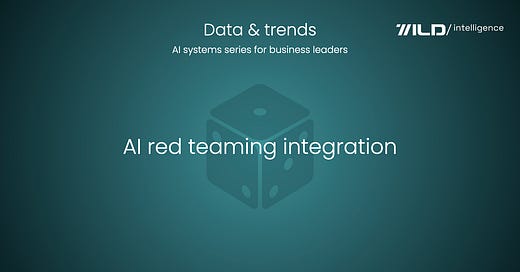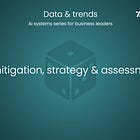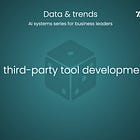🎲 AI red teaming integration
AI data and trends for business leaders | AI systems series
Hello,
Small reminder: this is the fourth post of a new series in the data and trends section.
The new series presents another angle, slightly different from the previous series that seeded the TOP framework1 and serves as the building block of our vision of AI safety implementation.
In this new series, we focus on more advanced topics in subsequent weeks, where we'll delve deeper into specific measurement methodologies and implementation strategies.
I believe this series will contribute significantly to the ongoing development of robust AI safety practices.—Yael.
Previous posts from the series:
AI red teaming integration
AI red team integration is a critical component of robust AI safety practices. It involves the strategic deployment of adversarial testing to uncover vulnerabilities and improve system resilience. By simulating real-world attack scenarios, red teams provide invaluable insights into potential weaknesses, enabling developers to strengthen defenses and mitigate risks.
Red Team Methodology and Best Practices:
Red teaming in AI involves a structured approach, encompassing:
Threat modeling: Identifying potential attack vectors and vulnerabilities based on the specific AI system and its intended use case.
Adversarial attacks: Developing and executing targeted attacks to exploit identified vulnerabilities, including prompt injection, data poisoning, and model inversion.
Scenario simulation: Simulating realistic scenarios to assess the system's response to adversarial inputs and unexpected conditions.
Documentation and reporting: Documenting attack methodologies, findings, and recommendations for remediation.
Best practices include:
Diverse red team composition: Including experts from various domains, such as security, AI, and ethics, to ensure comprehensive coverage.
Ethical considerations: Adhering to ethical guidelines and legal frameworks to ensure responsible testing practices.
Transparency and collaboration: Fostering open communication and collaboration between red teams and development teams.
Incorporating red team findings into measurement systems:
Red team findings should be integrated into measurement systems to view AI safety comprehensively. This involves:
Developing metrics: Creating metrics to quantify the effectiveness of red team attacks and the resilience of AI systems.
Integrating findings into dashboards: Visualizing red team findings and metrics in dashboards to provide real-time insights into system vulnerabilities.
Automating data collection: Automating the collection and analysis of red team data to ensure continuous monitoring.
Continuous red team testing frameworks:
Continuous red team testing frameworks enable the ongoing evaluation of AI systems, ensuring that safety measures remain effective over time. This involves:
Automating red team attacks: Developing automated tools and scripts to execute red team attacks.
Integrating with CI/CD pipelines: Incorporating red team testing into the continuous integration and continuous deployment (CI/CD) pipeline.
Scheduling regular attacks: Scheduling regular red team attacks to identify emerging vulnerabilities.
Feedback loops and iteration processes:
Feedback loops are essential for incorporating red team findings into the development process. This involves:
Rapid reporting: Providing timely feedback to development teams on identified vulnerabilities.
Collaborative remediation: Working collaboratively to develop and implement remediation strategies.
Iterative testing: Conducting iterative testing to verify the effectiveness of remediation efforts.
Measuring red team effectiveness:
Measuring red team effectiveness involves quantifying the impact of their efforts on AI safety. This can be achieved by:
Tracking vulnerability discovery: Measuring the number and severity of vulnerabilities discovered by the red team.
Assessing remediation success: Evaluating the effectiveness of remediation strategies in mitigating identified vulnerabilities.
Measuring reduced risk: Quantifying the reduction in risk associated with red team findings and remediation efforts.
Real-world case studies:
Companies developing autonomous vehicles employ red teaming to simulate various driving scenarios and identify potential safety hazards.
Financial institutions use red teaming to test the resilience of their AI-powered fraud detection systems.
Government agencies utilize red teaming to evaluate the security of AI systems used in critical infrastructure.
By integrating red team methodologies into AI development and deployment, organizations can proactively identify and mitigate vulnerabilities, ensuring the safety and reliability of their AI systems.
To address this, business leaders must consider:
How are you structuring your red team operations to ensure they remain adaptable and effective in the face of rapidly evolving AI models and attack vectors? How do you balance the need for rigorous testing with the potential for disruptions to development timelines?
What mechanisms are in place to translate the often technical findings of your red teams into actionable insights for non-technical stakeholders, such as executives and policymakers, to inform strategic decisions regarding AI safety and deployment?






